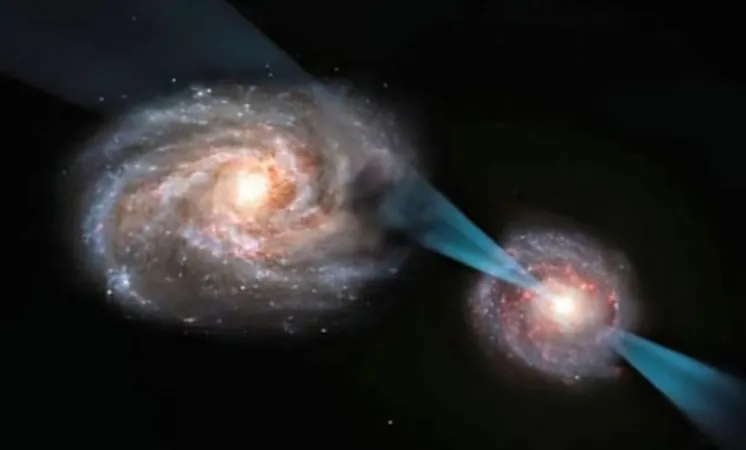
Galactic Collision Unveils Quasar's Star-Busting Power!
2025-05-25
Author: Daniel
Unprecedented Cosmic Collision!
In a groundbreaking discovery, astronomers have uncovered a spectacular encounter between two ancient galaxies that challenges our understanding of cosmic dynamics. A high-speed clash, taking place over 11 billion years ago, reveals one galaxy bombarding the other with intense radiation, thereby stifling new star formation.
Meet the Cosmic Duelists!
Led by renowned researchers Pasquier Noterdaeme from the Paris Institute of Astrophysics and Sergei Balashev from the Ioffe Institute in Russia, the study sheds light on a pair of galaxies hurtling toward each other at an astonishing 310 miles per second. This epic cosmic joust significantly impacts one galaxy's ability to create new stars.
The Power of Quasar Energy!
At the heart of this galactic drama lies a quasar—an intense beacon formed when massive amounts of matter spiral into a supermassive black hole. This quasar radiates energy so powerful that it disrupts and transforms the gas clouds in its unsuspecting neighbor. Noterdaeme aptly refers to this phenomenon as a 'cosmic joust,' highlighting the dynamic interplay of these celestial giants.
Star Formation Hits a Wall!
Remarkably, the intense quasar radiation has drastically altered the internal structure of the attacked galaxy's gas. Observations show that only the smallest, densest gas pockets have weathered the storm, yet they are too tiny—some less than 0.02 light-years across—to foster significant star formation.
A Glimpse into Cosmic Evolution!
This interaction serves as a crucial insight into negative feedback processes, where energy from black holes actively suppresses star formation in surrounding regions. Despite being a relic from the early universe, this collision offers a rare real-time view into galaxy and quasar evolution, affirming theories about the relationship between black holes and star formation.
Advanced Observations Paint a Clearer Picture!
Employing state-of-the-art telescopes like the Atacama Large Millimeter/submillimeter Array (ALMA) and the Very Large Telescope (VLT), astronomers disentangle the chaotic interplay of these celestial bodies, revealing the true nature of what was once thought to be a single fuzzy entity. The intense radiation from the quasar was directly linked to disturbances in the gas clouds of the attacked galaxy, providing fresh fuel for the ravenous black hole.
The Aftermath of Galactic Fusion!
As galaxies collide, they not only create turmoil but also feed the supermassive black holes nestled within. This cycle allows black holes to flare up as quasars—a phenomenon more prevalent in the early universe when such interactions were common. Looking forward, researchers are eager to employ the Extremely Large Telescope to delve deeper into these cosmic collisions.
A Stellar Publication!
Published in the prestigious journal Nature, this study not only ignites curiosity about the dynamism of galaxies and quasars but also encourages us to explore the uncharted territories of our universe.
 Brasil (PT)
Brasil (PT)
 Canada (EN)
Canada (EN)
 Chile (ES)
Chile (ES)
 Česko (CS)
Česko (CS)
 대한민국 (KO)
대한민국 (KO)
 España (ES)
España (ES)
 France (FR)
France (FR)
 Hong Kong (EN)
Hong Kong (EN)
 Italia (IT)
Italia (IT)
 日本 (JA)
日本 (JA)
 Magyarország (HU)
Magyarország (HU)
 Norge (NO)
Norge (NO)
 Polska (PL)
Polska (PL)
 Schweiz (DE)
Schweiz (DE)
 Singapore (EN)
Singapore (EN)
 Sverige (SV)
Sverige (SV)
 Suomi (FI)
Suomi (FI)
 Türkiye (TR)
Türkiye (TR)
 الإمارات العربية المتحدة (AR)
الإمارات العربية المتحدة (AR)